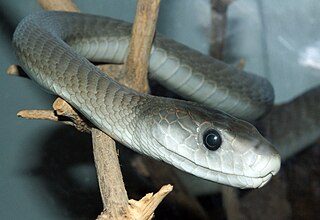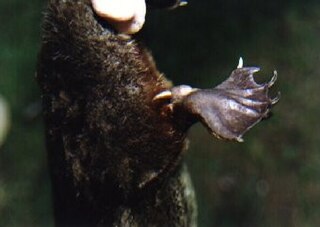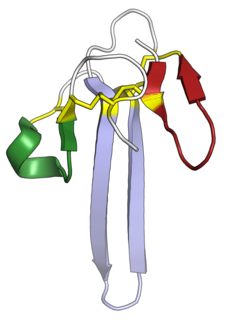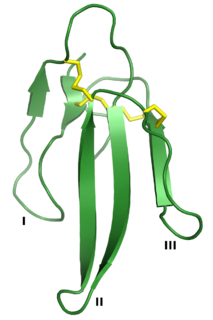Related Research Articles
Peptides are short chains of between two and fifty amino acids, linked by peptide bonds. Chains of fewer than ten or fifteen amino acids are called oligopeptides, and include dipeptides, tripeptides, and tetrapeptides.

Atrial natriuretic peptide (ANP) or atrial natriuretic factor (ANF) is a natriuretic peptide hormone secreted from the cardiac atria that in humans is encoded by the NPPA gene. Natriuretic peptides are a family of hormone/paracrine factors that are structurally related. The main function of ANP is causing a reduction in expanded extracellular fluid (ECF) volume by increasing renal sodium excretion. ANP is synthesized and secreted by cardiac muscle cells in the walls of the atria in the heart. These cells contain volume receptors which respond to increased stretching of the atrial wall due to increased atrial blood volume.

The black mamba is a species of highly venomous snake belonging to the family Elapidae. It is native to parts of sub-Saharan Africa. First formally described by Albert Günther in 1864, it is the second-longest venomous snake after the king cobra; mature specimens generally exceed 2 m and commonly grow to 3 m. Specimens of 4.3 to 4.5 m have been reported. Its skin colour varies from grey to dark brown. Juvenile black mambas tend to be paler than adults and darken with age.

The eastern green mamba is a highly venomous snake species of the mamba genus Dendroaspis native to the coastal regions of southern East Africa. Described by Scottish surgeon and zoologist Andrew Smith in 1849, it has a slender build with bright green upperparts and yellow-green underparts. The adult female averages around 2 metres in length, and the male is slightly smaller.

The western green mamba is a long, thin, and highly venomous snake of the mamba genus, Dendroaspis. This species was first described in 1844 by American herpetologist Edward Hallowell. The western green mamba is a fairly large and predominantly arboreal species, capable of navigating through trees swiftly and gracefully. It will also descend to ground level to pursue prey such as rodents and other small mammals.
Calcicludine (CaC) is a protein toxin from the venom of the green mamba that inhibits high-voltage-activated calcium channels, especially L-type calcium channels.

Calciseptine (CaS) is a natural neurotoxin isolated from the black mamba Dendroaspis p. polylepis venom. This toxin consists of 60 amino acids with four disulfide bonds. Calciseptine specifically blocks L-type calcium channels, but not other voltage-dependent Ca2+ channels such as N-type and T-type channels.

The platypus is one of the few living mammals to produce venom. The venom is made in venom glands that are connected to hollow spurs on their hind legs. Venom is primarily made during mating season. While the venom's effects are described as extremely painful, it is not lethal to humans. Many archaic mammal groups possess similar tarsal spurs, so it is thought that, rather than having developed this characteristic uniquely, the platypus simply inherited this characteristic from its antecedents. Rather than being a unique outlier, the platypus is the last demonstration of what was once a common mammalian characteristic, and it can be used as a model for non-therian mammals and their venom delivery and properties.
A natriuretic peptide is a peptide that induces natriuresis, which is the excretion of sodium by the kidneys.

Urodilatin (URO) is a hormone that causes natriuresis by increasing renal blood flow. It is secreted in response to increased mean arterial pressure and increased blood volume from the cells of the distal tubule and collecting duct. It is important in oliguric patients as it lowers serum creatinine and increases urine output.

Natriuretic peptide precursor C, also known as NPPC, is a protein that in humans is encoded by the NPPC gene. The precursor NPPC protein is cleaved to the 22 amino acid peptide C-type natriuretic peptide (CNP).
Cenderitide is a natriuretic peptide developed by the Mayo Clinic as a potential treatment for heart failure. Cenderitide is created by the fusion of the 15 amino acid C-terminus of dendroaspis natriuretic peptide (DNP) with the full C-type natriuretic peptide (CNP) structure both peptide which are endogenous to humans. This peptide chimera is a dual activator of the natriuretic peptide receptors NPR-A and NPR-B and therefore exhibits the natriuretic and diuretic properties of DNP, as well as the antiproliferative and antifibrotic properties of CNP.

Muscarinic toxin 7 (MT7) is one member of a family of small peptides of 65 amino acid residues derived from the venom of African mamba snakes, which mainly target M1-subtype of muscarinic receptor. Muscarinic toxins like the nicotinic toxins have the three-finger fold structure, characteristic of the large superfamily of toxins that act at cholinergic synapses.

Jameson's mamba is a highly venomous snake species of the mamba genus Dendroaspis native to equatorial Africa. Described by Scottish polymath Thomas Traill in 1843, it has a slender build with dull green upperparts and cream underparts and reaches around 2.2 meters (7.2 ft) in length. Two subspecies are recognised.

Muscarinic toxin 2 (MT2) is one member of a family of small peptides of 65 amino acid residues of around 7076 daltons in molecular weight derived from the venom of African mamba snakes, which target the different muscarinic receptor subtypes. Muscarinic toxins like the nicotinic toxins have the three-finger fold structure, characteristic of the large superfamily of toxins that act at cholinergic synapses. The interactions of muscarinic toxins studied using tritiated 3H-N-methyl scopolamine (NMS) with human muscarinic receptor subtypes m1, m2, m3 and m4 has shown that MT2 and the related MT1 toxin are specific for M1 and M4 receptors, but have little effect on binding to M2 and M3 receptors. The interaction at M1 receptors appears to be essentially irreversible like for muscarinic toxin 7.

Mambalgins are peptides found in the venom of the black mamba, an elapid snake. Mambalgins are members of the three-finger toxin (3FTx) protein family and have the characteristic three-finger protein fold. First reported by French researchers in 2012, mambalgins are unusual members of the 3FTx family in that they have the in vivo effect of causing analgesia without apparent toxicity. Their mechanism of action is potent inhibition of acid-sensing ion channels.

Muscarinic toxin 1 (MT1) belongs to the family of small peptides of 65 amino acid residues derived from the venom of African mamba snakes, with dual specificity for muscarinic receptor subtypes M1 and M4. Muscarinic toxins like the nicotinic toxins have the three-finger fold structure, characteristic of the large superfamily of toxins that act at cholinergic synapses.

Three-finger toxins are a protein superfamily of small toxin proteins found in the venom of snakes. Three-finger toxins are in turn members of a larger superfamily of three-finger protein domains which includes non-toxic proteins that share a similar protein fold. The group is named for its common structure consisting of three beta strand loops connected to a central core containing four conserved disulfide bonds. The 3FP protein domain has no enzymatic activity and is typically between 60-74 amino acid residues long. Despite their conserved structure, three-finger toxin proteins have a wide range of pharmacological effects. Most members of the family are neurotoxins that act on cholinergic intercellular signaling; the alpha-neurotoxin family interacts with muscle nicotinic acetylcholine receptors (nAChRs), the kappa-bungarotoxin family with neuronal nAChRs, and muscarinic toxins with muscarinic acetylcholine receptors (mAChRs).

Ventricular natriuretic peptide or brain natriuretic peptide (BNP), also known as B-type natriuretic peptide, is a hormone secreted by cardiomyocytes in the heart ventricles in response to stretching caused by increased ventricular blood volume.
References
- 1 2 3 Schweitz, Hugues; Vigne, Paul; Moinier, Danielle; Frelin, Christian; Lazdunski, Michel (1992). "A new member of the natriuretic peptide family is present in the venom of the green mamba (Dendroaspis angusticeps)". The Journal of Biological Chemistry. 267 (20): 13928–13932. doi:10.1016/S0021-9258(19)49658-0. PMID 1352773.
- 1 2 Park, Seon-Ah; Kim, Tae-Geun; Han, Myung-Kwan; Ha, Ki-Chan; Kim, Sung-Zoo; Kwak, Yong-Geun (June 2012). "Dendroaspis natriuretic peptide regulates the cardiac L-type Ca 2+ channel activity by the phosphorylation of α 1c proteins". Experimental & Molecular Medicine. 44 (6): 363–368. doi:10.3858/emm.2012.44.6.041. ISSN 2092-6413. PMC 3389074 . PMID 22366884.